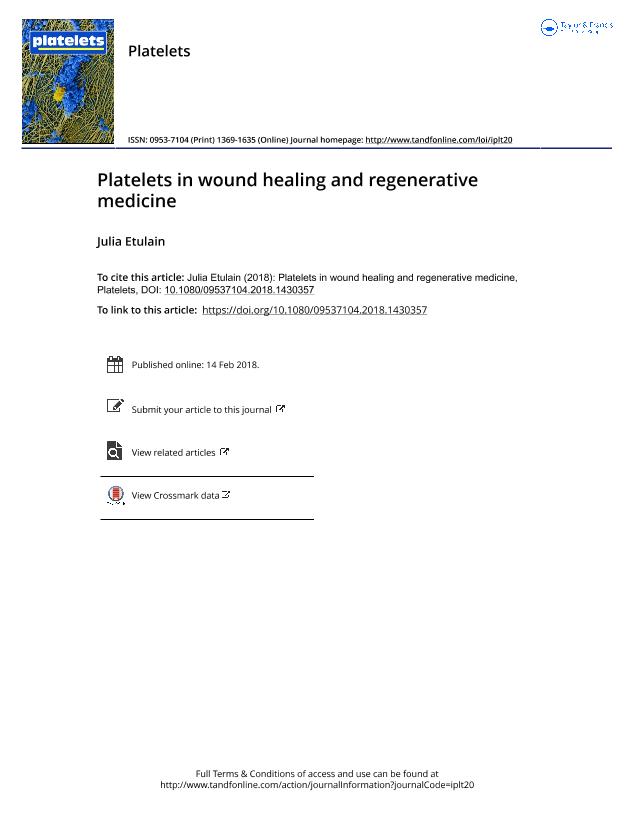Mostrar el registro sencillo del ítem
dc.contributor.author
Etulain, Julia

dc.date.available
2020-01-07T21:27:45Z
dc.date.issued
2018-08
dc.identifier.citation
Etulain, Julia; Platelets in wound healing and regenerative medicine; Taylor & Francis Ltd; Platelets; 29; 6; 8-2018; 556-568
dc.identifier.issn
0953-7104
dc.identifier.uri
http://hdl.handle.net/11336/93928
dc.description.abstract
Although platelets are widely recognized as having a critical role in primary hemostasis and thrombosis, increasing experimental and clinical evidence identifies these enucleated cells as relevant modulators of other physiopathological processes including inflammation and tissue regeneration. These phenomena are mediated through the release of growth factors, cytokines, and extracellular matrix modulators that sequentially promote (i) revascularization of damaged tissue through the induction of migration, proliferation, differentiation, and stabilization of endothelial cells in new blood vessels; (ii) restoration of damaged connective tissue through migration, proliferation, and activation of fibroblasts; and (iii) proliferation and differentiation of mesenchymal stem cells into tissue-specific cell types. For these reasons, platelet-rich plasma (PRP) derivatives are used in regenerative medicine for the treatment of several clinical conditions including ulcers, burns, muscle repair, bone diseases, and tissue recovery following surgery. The benefits of PRP administration are associated with an economical advantage, taking into consideration that PRP administration does not require complex equipment or training for its execution. Moreover, due to their primary autologous origin, concerns of disease transmission or immunogenic reactions can be disregarded. Thus, platelet-enriched materials have become highly relevant in the last decade and constitute a growing focus of experimental and clinical study in the context of wound healing and tissue regeneration. However, despite the diverse applications, the efficacy of regenerative treatments using PRP is being called into question due to the lack of large controlled clinical trials and the lack of consensus regarding the PRP preparation techniques. This review describes the biological mechanisms underlying PRP’s regenerative effects, the different methods of preparation and application of these biomaterials, and the controversies and future prospects related to the use of PRP in regenerative medicine.
dc.format
application/pdf
dc.language.iso
eng
dc.publisher
Taylor & Francis Ltd

dc.rights
info:eu-repo/semantics/openAccess
dc.rights.uri
https://creativecommons.org/licenses/by-nc-sa/2.5/ar/
dc.subject
GROWTH FACTORS
dc.subject
INFLAMMATION RESOLUTION
dc.subject
PLATELET-RICH PLASMA
dc.subject
PLATELETS
dc.subject
REGENERATIVE MEDICINE
dc.subject
WOUND HEALING
dc.subject.classification
Otras Ciencias de la Salud

dc.subject.classification
Ciencias de la Salud

dc.subject.classification
CIENCIAS MÉDICAS Y DE LA SALUD

dc.title
Platelets in wound healing and regenerative medicine
dc.type
info:eu-repo/semantics/article
dc.type
info:ar-repo/semantics/artículo
dc.type
info:eu-repo/semantics/publishedVersion
dc.date.updated
2019-10-18T18:03:27Z
dc.identifier.eissn
1369-1635
dc.journal.volume
29
dc.journal.number
6
dc.journal.pagination
556-568
dc.journal.pais
Reino Unido

dc.journal.ciudad
Londres
dc.description.fil
Fil: Etulain, Julia. Consejo Nacional de Investigaciones Científicas y Técnicas. Instituto de Medicina Experimental. Academia Nacional de Medicina de Buenos Aires. Instituto de Medicina Experimental; Argentina
dc.journal.title
Platelets

dc.relation.alternativeid
info:eu-repo/semantics/altIdentifier/doi/https://doi.org/10.1080/09537104.2018.1430357
dc.relation.alternativeid
info:eu-repo/semantics/altIdentifier/url/https://www.tandfonline.com/doi/abs/10.1080/09537104.2018.1430357?journalCode=iplt20
Archivos asociados
